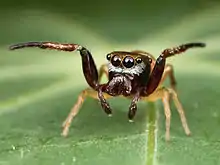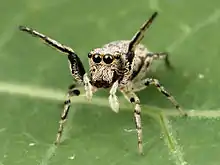| Zygoballus | |
|---|---|
 | |
| Adult male Zygoballus rufipes (hammerjawed jumper) from Massachusetts | |
| Scientific classification | |
| Domain: | Eukaryota |
| Kingdom: | Animalia |
| Phylum: | Arthropoda |
| Subphylum: | Chelicerata |
| Class: | Arachnida |
| Order: | Araneae |
| Infraorder: | Araneomorphae |
| Family: | Salticidae |
| Subfamily: | Salticinae |
| Genus: | Zygoballus Peckham & Peckham, 1885[1] |
| Type species | |
| Zygoballus rufipes Peckham & Peckham, 1885 | |
| Species | |
| Diversity | |
| approx. 20 species | |
| Synonyms | |
| |
Zygoballus is a genus of jumping spiders found in North and South America.
Taxonomy and history
The genus was first described in 1885 by American arachnologists George and Elizabeth Peckham based on the type species Zygoballus rufipes.[2] The name derives from a combination of the Ancient Greek word ζυγόν (zygon), meaning "yoke", and the genus name Ballus. The etymology of Ballus is unknown, but may be related to the Greek word βαλλίζω (ballizo), meaning "dance" or "jump about".[3]
The genus Messua, based on the type species Messua desidiosa, was synonymized with Zygoballus by Eugène Simon in 1903. Simon argued that Messua desidiosa was a transitional species which differed "much less from typical Zygoballus than would seem to be indicated by [the Peckham's] description."[4] This synonymy was reversed by Wayne Maddison in 1996, and Messua restored as a valid genus.[5]
The genus Amerotritte, based on the type species Amerotritte lineata, was synonymized with Zygoballus in 1980 by María Elena Galiano. Galiano stated that the holotype of Amerotritte lineata was actually a very young Zygoballus specimen.[6]
Zygoballus is currently classified in the subtribe Dendryphantina of the family Salticidae (jumping spiders).[7][8]
Description

Spiders of the genus Zygoballus share a strong resemblance in appearance.[9] The cephalothorax is high and roughly square when viewed from above.[10] It is widest at the posterior eyes, with the ocular quadrangle occupying approximately three-fifths of the cephalothorax.[9] The cephalothorax slopes steeply behind the posterior eyes and the sides of the cephalothorax are nearly vertical.[9] The labium is as long or longer than it is wide.[11] The anterior (first) pair of legs are the largest, with three pairs of spines on the ventral surface of the tibia.[12] Males have obliquely oriented chelicerae with long fangs.[9]
Many species exhibit wide variation in color, size, and markings.[10]
Distribution
Zygoballus is a genus from the New World, ranging from Argentina to Canada. Three species from India were originally placed in Zygoballus, but have been reassigned to other genera.[13]
Species
As of July 2016, the World Spider Catalog accepted the species listed below.[1] One species, Z. quaternus, was previously recognized (prior to 2008), but is now considered a nomen dubium.[14] Several other species are known only from single specimens. In addition to the species listed below, a 2001 phylogenetic analysis suggested that Rhetenor texanus may also belong in Zygoballus,[7] but this has not been accepted by the World Spider Catalog.
- Zygoballus amrishi Makhan, 2005 — Suriname
- Zygoballus aschnae Makhan, 2005 — Suriname
- Zygoballus concolor Bryant, 1940 — Cuba
- Zygoballus electus Chickering, 1946 — Panama
- Zygoballus gracilipes Crane, 1945 — Guyana, Argentina
- Zygoballus incertus (Banks, 1929) — Panama
- Zygoballus iridescens Banks, 1895 — USA
- Zygoballus lineatus (Mello-Leitão, 1944) — Argentina
- Zygoballus maculatipes Petrunkevitch, 1925 — Panama
- Zygoballus maculatus F. O. P-Cambridge, 1901 — Guatemala
- Zygoballus melloleitaoi Galiano, 1980 — Argentina
- Zygoballus minutus Peckham & Peckham, 1896 — Guatemala
- Zygoballus nervosus (Peckham & Peckham, 1888) — USA, Canada
- Zygoballus optatus Chickering, 1946 — Panama
- Zygoballus remotus Peckham & Peckham, 1896 — Guatemala
- Zygoballus rishwani Makhan, 2005 — Suriname
- Zygoballus rufipes Peckham & Peckham, 1885 — Canada to Costa Rica
- Zygoballus sexpunctatus (Hentz, 1845) — USA
- Zygoballus suavis Peckham & Peckham, 1895 — Jamaica
- Zygoballus tibialis F. O. P.-Cambridge, 1901 — Guatemala to Panama
References
- 1 2 "Gen. Zygoballus Peckham & Peckham, 1900", World Spider Catalog, Natural History Museum Bern, retrieved 2016-07-23
- ↑ Peckham, George; Peckham, Elizabeth (1885). "On some new genera and species of Attidae from the eastern part of Guatemala" (PDF). Proceedings of the Natural History Society of Wisconsin: 62–86.
- ↑ Ubick, D.; Paquin, P.; Cushing, P. E.; Roth, V., eds. (2005). Spiders of North America: An Identification Manual. American Arachnological Society. p. 330. ISBN 0-9771439-0-2.
- ↑ Simon, Eugène (1903). Histoire Naturelle des Araignées (in French) (2nd ed.). Paris. p. 863.
{{cite book}}: CS1 maint: location missing publisher (link) - ↑ Maddison, Wayne P. (1996). "Pelegrina Franganillo and other jumping spiders formerly placed in the genus Metaphidippus (Araneae: Salticidae)". Bulletin of the Museum of Comparative Zoology. Harvard University. 154: 215–368.
- ↑ Galiano, María Elena (1980). "Catalogo de los especimenes tipicos de Salticidae (Araneae) descriptos por Candido F. de Mello-Leitão". Physis, Revista de la Sociedad Argentina de Ciencias Naturales. Buenos Aires. 39: 31–40.
- 1 2 Hedin, Marshal C.; Maddison, Wayne P. (March 2001). "A Combined Molecular Approach to Phylogeny of the Jumping Spider Subfamily Dendryphantinae (Araneae: Salticidae)". Molecular Phylogenetics and Evolution. 18 (3): 386–403. doi:10.1006/mpev.2000.0883. PMID 11277632.
- ↑ Maddison, Wayne P. (November 2015). "A phylogenetic classification of jumping spiders (Araneae: Salticidae)" (PDF). Journal of Arachnology. 43 (3): 231–292. doi:10.1636/arac-43-03-231-292. S2CID 85680279. Retrieved 5 February 2017.
- 1 2 3 4 Peckham, George; Peckham, Elizabeth (1895). "Spiders of the Homalattus group of the family Attidae" (PDF). Occasional Papers of the Natural History Society of Wisconsin. 2 (3): 157–178.
- 1 2 Peckham, George; Peckham, Elizabeth (1909). "Revision of the Attidae of North America" (PDF). Transactions of the Wisconsin Academy of Sciences, Arts, and Letters. 16: 355–646.
- ↑ Ubick, D.; Paquin, P.; Cushing, P. E.; Roth, V., eds. (2005). Spiders of North America: An Identification Manual. American Arachnological Society. p. 213. ISBN 0-9771439-0-2.
- ↑ Kaston, Benjamin Julian (1981). Spiders of Connecticut (Revised ed.). State of Connecticut. p. 496.
- ↑ Kaldari, Ryan (2010). "Reassignment of the Indian species of Zygoballus to Bianor and Rhene (Araneae: Salticidae)" (PDF). Peckhamia. 82 (1).
- ↑ Richman, David B. (2008). "Revision of the jumping spider genus Sassacus (Araneae, Salticidae, Dendryphantinae) in North America" (PDF). Journal of Arachnology. 36 (1): 28–48. doi:10.1636/H07-03.1. S2CID 83998396.
External links
- Zygoballus at Bugguide.net
- Zygoballus at Salticidae: Diagnostic Drawings Library